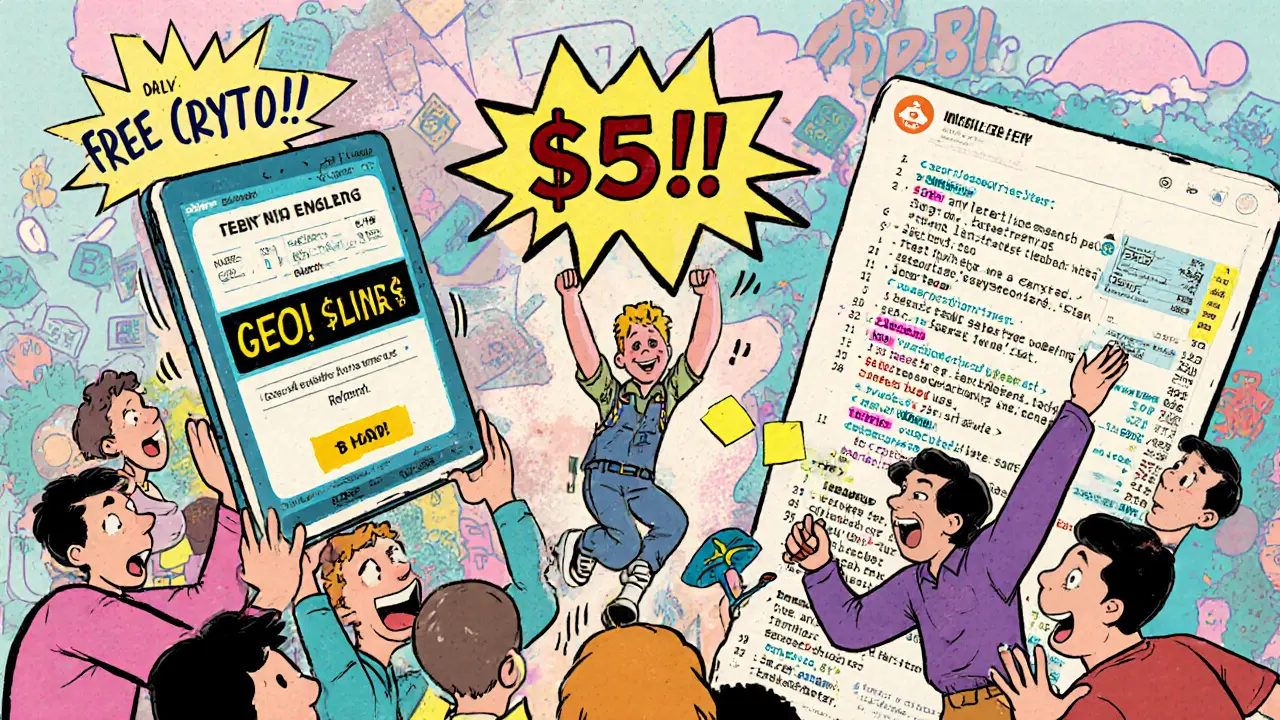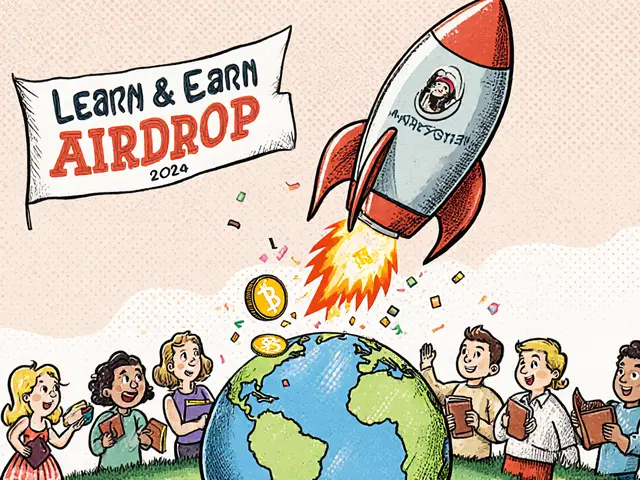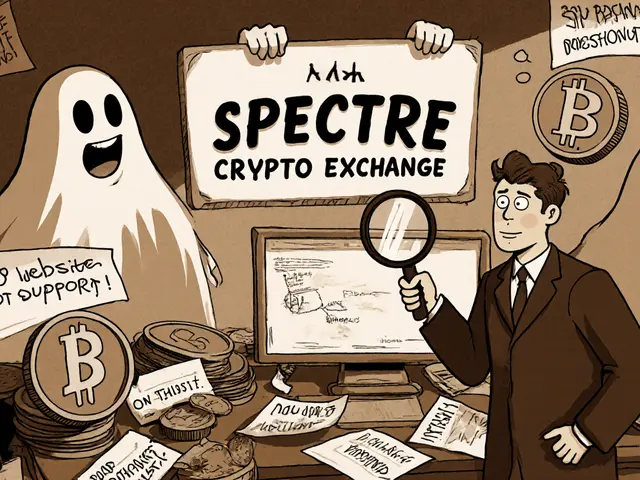
GEO Token Value Calculator
Your GEO tokens are worth: -
Back in 2020, if you downloaded a random app on your phone and started earning free cryptocurrency just by walking around, you weren’t imagining things. That was the GEO airdrop by GeoDB - a real, no-strings-attached token distribution that promised users cash for their location data. It wasn’t a scam. It wasn’t hype. It was a bold experiment in data ownership. And today, most people who joined have no idea what happened to their tokens.
What Was GeoDB and the GEO Airdrop?
GeoDB wasn’t trying to build another crypto coin. It wanted to flip the script on how big tech companies like Google and Facebook make billions from your data - while you get nothing. The idea was simple: if your phone tracks where you go, what you do, and when you’re online, then you should be paid for it. GeoDB built a mobile app that collected anonymous location and behavioral data, then rewarded users with GEO tokens - their native cryptocurrency.
The airdrop launched in mid-2020. You didn’t need to buy anything. You didn’t need to mine. You just downloaded the GeoDB app (Android or iOS), created a wallet inside it, and started earning. Every day, you got a small amount of GEO - sometimes as much as 5 to 10 tokens - just for having the app open and letting it collect data. The more you used your phone normally, the more you earned. No extra work. No surveys. Just walk, shop, scroll - and get paid.
How Did the Airdrop Actually Work?
The system had three layers:
- Base Earnings - You got daily GEO tokens just by running the app. The amount varied by region, device type, and data quality, but most users reported 1-10 GEO per day.
- Referral Bonuses - Invite a friend using your code (like MDHALIM759_PXGYZQ), and both of you got extra tokens. Some users earned hundreds of GEO this way.
- Regional Campaigns - GeoDB ran targeted promotions. One notable example offered 10 free GEO tokens to the first 2,000 users in India who signed up through Bitforex.
Users had to accept terms, enable location permissions, and secure their wallet’s 12-word recovery phrase. The app used a built-in wallet called Wallace Wallet to store GEO tokens. If you lost your phrase, you lost your tokens - no exceptions.
Why Did People Join?
At the time, crypto was exploding. Ethereum was surging. DeFi was everywhere. But most people still didn’t understand how to make money from it. GeoDB made it feel easy. A YouTube video from that period showed a guy earning $5 a day in GEO - and it went viral in niche communities. For many, especially in emerging markets like India, Nigeria, and Brazil, that was real money. Even $0.50 a day added up over a month.
It wasn’t just about the cash. It was about control. For the first time, users felt like they were part of a system that rewarded them - not exploited them. That emotional hook was powerful. Thousands downloaded the app. Telegram groups exploded. Reddit threads filled up with screenshots of daily earnings.

What Happened to GEO Tokens?
The airdrop ended in late 2021. GeoDB stopped promoting it. The app kept running, but daily rewards dried up. Then came the big shift: the project migrated from Ethereum to a new chain called ODIN Chain.
That migration was messy. Not everyone understood how to claim their tokens on the new network. Some users missed the window. Others lost access because they didn’t back up their keys. By 2023, the GeoDB app was barely updated. Wallace Wallet still worked, but the interface looked outdated. The website became a ghost town.
Today, GEO tokens still exist - but barely. CoinGecko shows the price at $0.0001664 as of late 2025. That’s down over 90% from its peak. The 24-hour trading volume? Just $120.24. You can trade GEO on Uniswap V2, but the last trades happened days ago. The total supply is 313 million tokens, but only 82 million are circulating. The rest? Locked up, unsold, or lost.
Is GEO Still Worth Anything?
For most people - no. If you held onto your tokens from 2020, you’re sitting on pennies. Even if you earned 10,000 GEO (a high earner), that’s only $1.66 today. That’s not a fortune. It’s not even lunch money.
But here’s the twist: GEO isn’t dead. It’s just quiet. The team behind it still maintains Wallace Wallet and the ODIN Chain infrastructure. There’s no announcement of a new airdrop. No roadmap update. No social media buzz. But the code is still live. The wallet still works. And if someone ever rebuilds the data marketplace - GEO could come back.
Think of it like an old USB drive you forgot about. You don’t use it. But if you plug it in, you might still find something valuable inside.

What You Can Learn from the GeoDB Airdrop
The GeoDB experiment failed as a mass-market success. But it succeeded as a proof of concept. It proved that:
- People will participate in crypto if it’s simple and feels fair.
- Location data is valuable - and users are willing to trade it for rewards.
- Airdrops can drive real adoption, not just speculation.
Today, companies like Helium and Hivemapper are building on the same idea - paying users for data. But they’re smarter. They use clearer tokenomics. Better wallets. Stronger marketing. GeoDB was the first. And it was messy.
If you still have GEO tokens in your Wallace Wallet, don’t delete the app. Keep the recovery phrase safe. Hold it. Don’t expect it to rise. But don’t give up on it either. Crypto moves in cycles. What’s dead today might be revived tomorrow - especially if the data economy finally wakes up.
What’s Next for GeoDB and GEO?
No one knows. The team hasn’t posted anything public since 2022. Their last official update was a GitHub commit about ODIN Chain optimizations. No press releases. No Twitter threads. No Discord events.
That silence speaks volumes. Either they’re quietly rebuilding, or they’ve moved on. The lack of communication is the biggest red flag. In crypto, silence usually means one of two things: you’re building in secret - or you’re gone.
For now, GEO is a relic. A footnote in the history of crypto airdrops. But it’s a meaningful one. It showed that users want to own their data. And that’s not going away.
Was the GeoDB airdrop real or a scam?
The GeoDB airdrop was real. Thousands of users received GEO tokens between 2020 and 2021 by downloading the official app and participating in daily data collection. There were no upfront payments required. The tokens were distributed via smart contracts on Ethereum. However, the project later became inactive, and the value of GEO dropped dramatically - which is common for experimental crypto projects.
Can I still claim GEO tokens from the 2020 airdrop?
No. The official airdrop campaign ended in late 2021. There is no active mechanism to claim new tokens. If you already received GEO tokens and still have them in your Wallace Wallet, you can access them - but you cannot earn more through the original airdrop program.
Where can I trade GEO tokens today?
GEO tokens are still tradable on Uniswap V2 (Ethereum) using the GEO/WETH pair. The trading volume is extremely low, with only about $120 traded in 24 hours as of late 2025. There are no major exchanges listing GEO anymore. Be cautious - low liquidity means large price swings and difficulty selling.
What is Wallace Wallet, and do I still need it?
Wallace Wallet was the official wallet for storing GEO tokens. It’s still functional and supports the ODIN Chain migration. If you have GEO tokens, you need Wallace Wallet to access them. The app is available on Android and iOS. Do not delete it unless you’ve transferred your tokens elsewhere - and even then, keep your recovery phrase saved.
Why did GeoDB migrate from Ethereum to ODIN Chain?
GeoDB moved to ODIN Chain to reduce transaction fees and improve scalability. Ethereum’s high gas costs made small daily rewards impractical. ODIN Chain was designed as a lightweight blockchain optimized for data monetization. However, the migration was poorly communicated, leading to confusion and lost tokens among users who didn’t follow the steps.
Is there a chance GEO will rise in value again?
It’s unlikely unless there’s a major revival of the GeoDB ecosystem. The token has no active development, marketing, or community engagement. While the idea of paying users for data is still valid, GEO itself has lost momentum. Other projects like Hivemapper and Helium are now leading that space. GEO’s value now depends entirely on speculation - not utility.
What should I do if I still have GEO tokens?
Keep your Wallace Wallet installed and your 12-word recovery phrase stored securely offline. Do not send your tokens to unknown addresses. You can check your balance on Etherscan using the contract address 0x147f...126750. If you want to sell, use Uniswap V2 - but expect low liquidity and small returns. Treat it as a learning experience, not an investment.




Comments (15)
Anthony Allen
Man, I remember downloading that app during lockdown. I thought I was gonna get rich walking to the fridge. Ended up with like 300 GEO and now I can’t even buy a coffee with it. Funny how crypto dreams die so quietly.
Stephanie Tolson
What GeoDB did was radical for its time. It didn’t just promise ownership-it gave people a taste of it. Most crypto projects still treat users like data mines. GeoDB actually tried to flip the script. Even if it failed, it planted a seed. That’s more than most can say.
Jeana Albert
Of course it failed. People don’t want to own their data-they want free money. And when the money stopped, they screamed fraud. But the real fraud was believing a startup with no marketing budget could outmaneuver Google. Wake up.
Vipul dhingra
guy in india got 10 geo for signing up through bitforex and now he's rich right lol
Chris Hollis
Low volume, dead community, no dev activity. The math is clear. GEO is a zombie token. The only value left is nostalgia. And even that’s fading. Don’t romanticize dead projects. It’s not wisdom-it’s denial.
Evan Koehne
So we’re supposed to keep the app because maybe, in 2030, someone will remember what GEO stood for? That’s not a strategy. That’s a museum exhibit labeled ‘Crypto’s First Naive Dream.’
Angie McRoberts
I still have my Wallace Wallet open on my phone. I don’t check the balance. I just like knowing it’s there. Like a letter from a past version of myself. Hopeful. Naive. Alive.
Jacque Hustead
I think the real lesson isn’t about GEO-it’s about how we treat early adopters. They took a risk on something unproven, not for profit, but for principle. And then the project vanished. That’s not a crypto failure. That’s a human one.
Sarah Scheerlinck
I was in college when I joined. I earned enough to buy a month of data. That’s all. But I felt like I was part of something bigger. Like I wasn’t just a user-I was a participant. That feeling? It’s rare. And I miss it.
Megan Peeples
Let’s be honest: the entire project was a poorly executed PR stunt disguised as a movement. The ‘data ownership’ rhetoric was a cover for a vanity project that couldn’t even get a decent UI. And now people are romanticizing it like it was a revolution? Please.
gerald buddiman
My god, I still have 7,800 GEO. I checked last week. I didn’t even remember I had it. I opened Wallace Wallet, stared at the balance, and cried a little. Not because it’s worth anything-but because I believed. And that’s the real loss.
Robert Bailey
Keep the wallet. Keep the phrase. Don’t stress. Crypto’s a long game. Maybe next cycle someone picks this up. Maybe not. Either way-you tried. That’s more than most.
Natalie Nanee
People still clinging to GEO are like those who still have BlockFi statements. You didn’t lose money-you lost faith. And that’s harder to recover.
Wendy Pickard
I deleted the app. But I kept my recovery phrase in a fireproof safe. Not because I think it’ll be worth anything. But because I owe it to the version of me who believed in it.
karan thakur
GeoDB was a Western scam targeting poor countries. They collected data from Indian users and vanished. Now they say it’s a "learning experience." What a joke. We gave our data, they took our trust. No apology. No refund. Just silence.